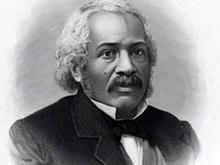Description
James McCune Smith (April 18, 1813 – November 17, 1865) was an American physician, apothecary, abolitionist, and author. He is the first African American to hold a medical degree and graduated at the top in his class at the University of Glasgow, Scotland. He was the first African American to run a pharmacy in the United States.
In addition to practicing as a doctor for nearly 20 years at the Colored Orphan Asylum in Manhattan, Smith was a public intellectual: he contributed articles to medical journals, participated in learned societies, and wrote numerous essays and articles drawing from his medical and statistical training. He used his training in medicine and statistics to refute common misconceptions about race, intelligence, medicine, and society in general. Invited as a founding member of the New York Statistics Society in 1852, which promoted a new science, he was elected as a member in 1854 of the recently founded American Geographic Society. But, he was never admitted to the American Medical Association or local medical associations.
He has been most well known for his leadership as an abolitionist; a member of the American Anti-Slavery Society, with Frederick Douglass he helped start the National Council of Colored People in 1853, the first permanent national organization for blacks. Douglass said that Smith was “the single most important influence on his life.” Smith was one of the Committee of Thirteen, who organized in 1850 in New York City to resist the newly passed Fugitive Slave Law by aiding fugitive slaves through the Underground Railroad. Other leading abolitionist activists were among his friends and colleagues. From the 1840s, he lectured on race and abolitionism and wrote numerous articles to refute racist ideas about black capacities.
Both Smith and his wife were of mixed-race African and European ancestry. As he became economically successful, he built a house in a good neighborhood; in the 1860 census he and his family were classified in that neighborhood as white, whereas in 1850 they were classified as mulatto. He served for nearly 20 years as the doctor at the Colored Orphan Asylum in New York but, after it was burned down in July 1863 by a mob in the New York Draft Riots, in which nearly 100 blacks died, Smith moved his family and practice out to Brooklyn for safety. The parents stressed education for their children. In the 1870 census, his widow and children continued to be classified as white. To escape racial discrimination, his children passed into white society: the four surviving sons married white spouses; his unmarried daughter lived with a brother. They worked as teachers, a lawyer, and business people.
Smith’s unique achievements as a pioneering African-American doctor were rediscovered by twentieth-century historians. They were relearned by his descendants in the twenty-first century when a three-times-great-granddaughter took a history class and found his name in her grandmother’s family bible. In 2010, several Smith descendants commissioned a new tombstone for his grave in Brooklyn. They gathered to honor him and their African-American ancestry.
Notable Facts
- He is the first African American to hold a medical degree
- Graduated at the top in his class at the University of Glasgow, Scotland
- First African American to run a pharmacy in the US
- Leading Abolitionist
Connections
- graduate of University of Glasgow †
- described in The History of the Negro in Medicine †

